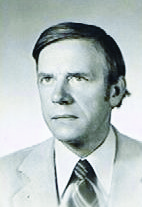Title of the work
Country of the First Edition
Country/countries of popularity
Original Language
First Edition Date
First Edition Details
Franciszek Kobryńczuk, “Hiacynt”, Biuletyn Północno-Wschodniej Izby Lekarsko-Weterynaryjnej [Bulletin of the North-Eastern Veterinary Chamber] 57.3 (2015): 98–99 (accessed: September 13, 2022).
ISBN
Available Onllne
Bulletin of the North-Eastern Veterinary Chamber 57.3 (2015): 98–99 (accessed: December 6, 2022).
Genre
Narrative poetry
Poetry
Target Audience
Children
Cover

We are still trying to obtain permission for posting the original cover.
Author of the Entry:
Maciej Skowera, University of Warsaw, mgskowera@uw.edu.pl
Peer-reviewer of the Entry:
Elżbieta Olechowska, University of Warsaw, elzbieta.olechowska@gmail.com
Katarzyna Marciniak, University of Warsaw, kamar@al.uw.edu.pl

Photograph courtesy of the Author.
Franciszek Kobryńczuk
, 1929 - 2016
(Author)
A veterinarian, professor of veterinary sciences specializing in animal anatomy (an authority on the anatomy of the Polish bison), writer, and poet. 1948–1950: a member of a secret youth organization active within the post-WW2 underground connected to Armia Krajowa [Home Army], banned by the Communist regime; in 1950 he was sentenced to a 10-year prison term for this activity; fully exonerated after the fall of Communism. Graduated from the Faculty of Veterinary Medicine of the Warsaw University of Life Sciences (SGGW); from 1994 to 2000 Head of the Department of Animal Anatomy at the same University. Debuted as an author for children in 1958 with a short poem Sowa [Owl], published in children’s magazine “Miś”; contributor to several other magazines for children and young adults, such as “Świerszczyk,” “Płomyk,” “Płomyczek,” and “Mały Apostoł”; author of about 30 books for children, young adults and adults; a former member of the Polish Writers’ Union; now his poems can be found most of all online. The page ewa.bicom.pl/wierszedzieci run by a Kobryńczuk’s admirer, Ewa Białek, functions as the official website for Kobryńczuk’s poems for children.
Source:
Materials kindly provided by the Author.
Bio prepared by Maciej Skowera, University of Warsaw, mgskowera@gmail.com
Summary
Hyacinth, a beautiful boy, is friends with Zephyrus, the god of the west wind, and Apollo, the god of beauty. With Zephyrus, Hyacinth runs while Apollo teaches him to play the lyre and zither, shoot the bow, and throw the discus. Zephyrus is jealous of Hyacinth and Apollo’s relationship. Therefore, when the friends throw a discus, the god of the wind blows on the instrument, and it flies on a different track, hitting Hyacinth and killing him. The distraught Apollo, unable to revive his friend, makes a flower grow from his blood, symbolizing suffering.
Analysis
Franciszek Kobryńczuk takes up one of his favourite subjects, namely metamorphosis, in this case – of human blood into a plant. What draws your attention in this short poem is the complete elimination of the theme of homoerotic love between Hyacinth and the two gods; they are all presented in the poem only as friends, and the erotic themes are removed entirely to adapt the work to the imagined qualities and needs of the reading audience, namely children. The internal thematic division is also important: the first and third stanzas focus on Zephyrus, while the second and fourth stanzas focus on Apollo – with only the god of beauty appearing at the end of the poem, which could be read as a recognition of him as a more important figure and companion to Hyacinth. Interestingly, the poem forms a ‘floral triptych’ with two other pieces dedicated to Adonis and Narcissus.
Further Reading
Entry: Hyakinthos at theoi.com (accessed September 13, 2022).
Madondo, Sibusiso Hyacinth, “‘A flower is a lovesome thing’: Myth Analysis of the Hyacinth”, TricTrac: Journal of World Mythology and Folklore 6.1 (2013): 28–39.
Nosek, Anna, W przestrzeniach universum i regio. Wiersze dla dzieci współczesnych pisarzy regionu podlaskiego – interpretacje [In the Spaces of universum and regio: Poems for Children by Contemporary Writers of the Podlasie Region – Interpretations], Białystok: Wydawnictwo Uniwersytetu w Białymstoku, 2015.
Addenda
Hyacinth is a plant name – a flower of the Hyacinthus genus.


